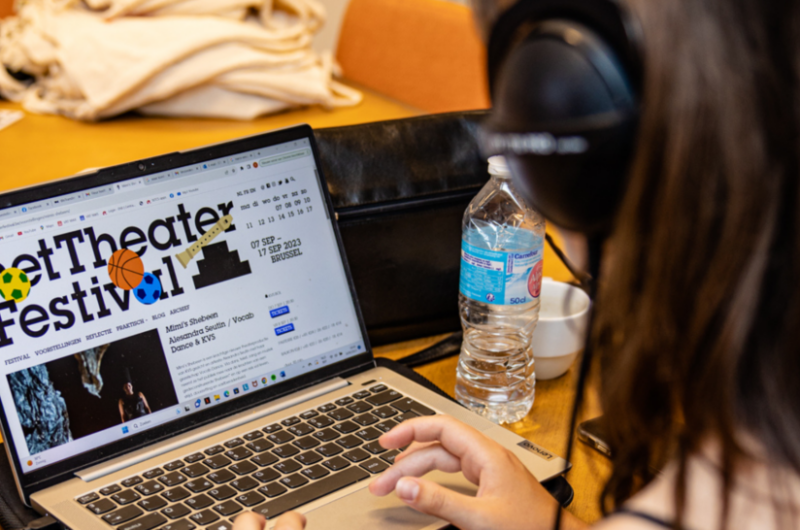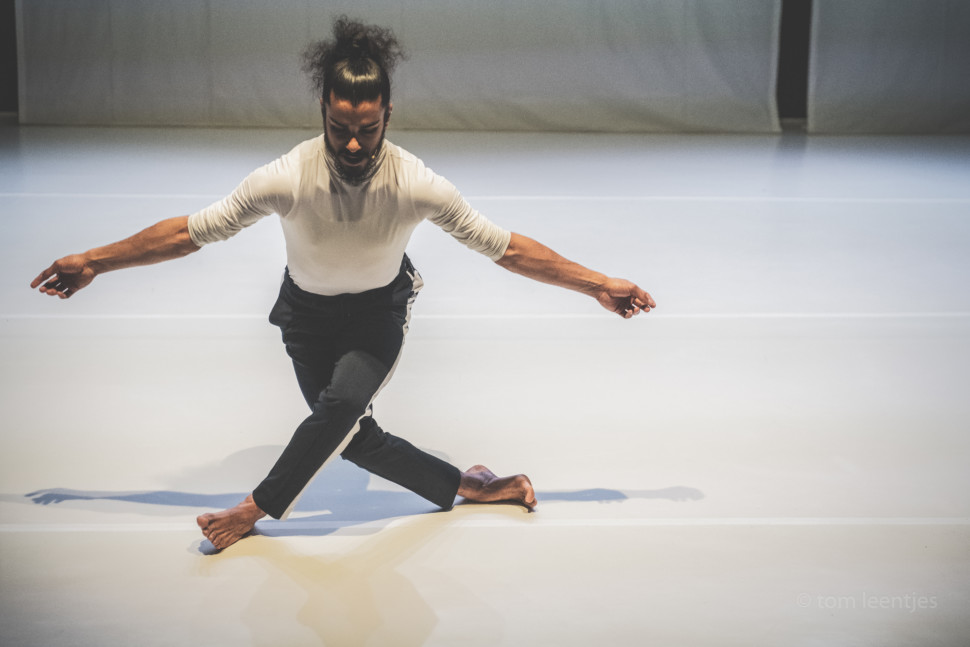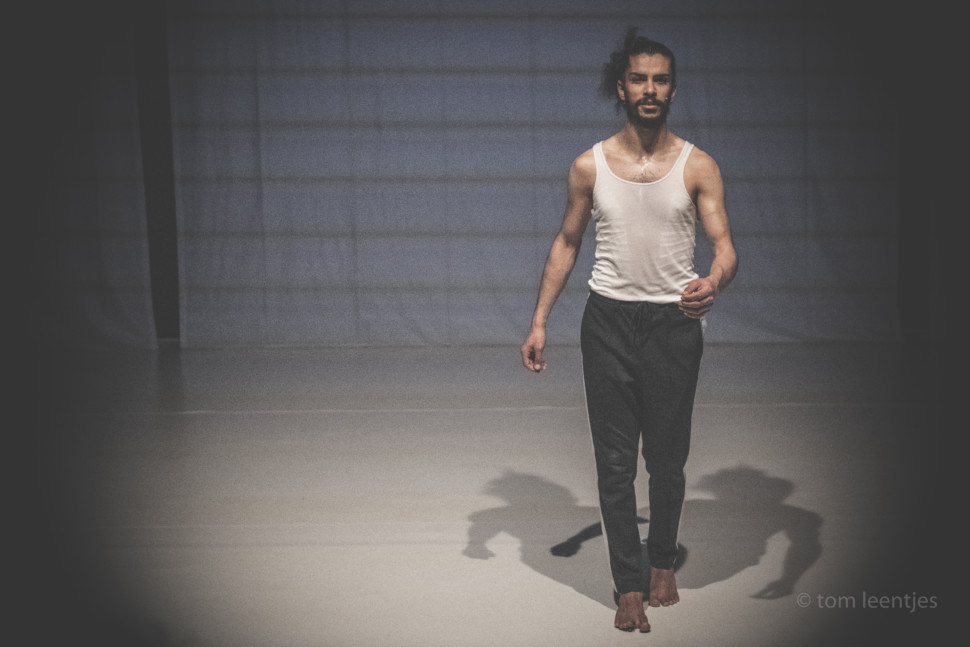
Stage: communicatie & sociale media
13 Maa 2024
za 14 sep 2019
For most of his life, Mohamed Toukabri has been dancing all over the world. It was his craft that allowed him to leave his hometown, Tunis, as a young boy and to set foot on a long road of discovery, taking him not only across geographical borders but also the ones he encountered within. Now, in his first solo-performance, The Upside Down Man, he shares his story of how not belonging to a specific place can create space to rid yourself of preconceived ideas about identity and misconceptions of the ‘other’.
Mahdieh Fahimi

© Tom Leentjes
You’ve danced for various professional companies from a young age. Now you are doing your first solo-performance, is this something you’ve always wanted to do?
Mohamed Toukabri: ‘Not really. It was more a natural result of what I had been doing so far in my career as a dancer. I started as a breakdancer and in breakdancing you practice a lot on your own, creating your own moves and such. Later, when I started working with the companies, it was also encouraged that the dancers were part of the creative process. The choreographers and theater directors would come up with their ideas and it was expected of us to turn those into concrete proposals. So, in a way, I was familiar with the act of creating and after several years of working for others, such as Needcompany and Sidi Larbi Cherkaoui, I felt the need to make my own personal work.’
‘But still, I didn’t know exactly what that work would be. Then, one day, something very interesting happened: I was in Tunis, visiting my family, and all of a sudden, I caught myself saying to my mom that I felt like going back home sooner than I had initially planned. It was the first time after all these years that I referred to Brussels as my home. It was a very confrontational moment for me. Not so much in an existential way, as I knew perfectly well who I was, but rather on a more societal level. If I feel like Belgium is my home does that mean that I also have to represent myself as a Belgian to the world? Can’t I be Tunisian anymore? It was in these questions that all the pieces fell together, because even in my self-awareness and my dancing I was moving in this in-between space as well.’
It’s not like you feel you had to leave one place in order to build a new life in another one?
‘No, I don’t. Most of the time, stories about immigrants are linked to very tragic events and of course I had my hardships but it’s not that I had to flee war or oppression, or hunger. I was simply a seeker of knowledge and very lucky that my dancing provided me with this opportunity to go out into the world. I felt it was necessary for me to talk about this positive side of migration and that it’s not always an element of destruction, that there are a lot of things that can grow from being in this position. I still see myself mostly as a traveler, because that’s what I have been doing since I was 15, you know? In a way, I consider the stage as my home and the audiences I meet everywhere as a part of my family, a part of this space I find myself in. That’s what I’ve been trying to do with The Upside Down Man, to transform the stage into the in-between.’
You also call yourself ‘The Son on the Road’…
‘That’s actually from a book by Amin Maalouf, called In the Name of Identity, which I’ve studied for my research. It really helped me through some heavier times. Maalouf says a very beautiful thing in his book: “I come from no country, from no city, no tribe. I am the son of the road… all tongues and all prayers belong to me. But I belong to none of them.” I found so much freedom in this. Now, I mostly try to connect with people, no matter what their nationality, colour or gender is. I want to know them and their story, not their label.’
In your show, you bring your own personal story but is it reductive to say that it is only about you?
‘I like poetic images and even though it is my own personal story that I bring on stage, I use that story as a tool for reflection, like some sort of mirror. Because I believe that if we want to, we can all find many similarities in each other’s stories. I also like to challenge some of the preconceived notions that we have of other people and their stories. Take myself for example, I’m an Arab man from a Muslim background. There are still a lot of misconceptions out there about who I’m supposed to be or how I’m expected to behave. So, I want to confront the audience with that, not by pointing a finger at them but by showing myself in my vulnerability of sharing my personal story.’

© Tom Leentjes
In telling this story, you not only use dance but also imagery, sound and word. Why did you feel that was necessary?
‘Even though I’m a dancer, my starting point wasn’t really movement. In the beginning it was a necessity for me to use words because I didn’t feel that I could say what I wanted to say just through dance. I needed the words just as much as I needed dance. It was quite a challenge for me, actually, as I’m not an actor and in the beginning, I struggled a lot with my text. It was a stark contrast with the virtuosity that I have in my movements as a dancer but then, I liked the fragility it allowed me to show on stage. I took a lot of care in how I address things because it’s not my intention to give a speech or to educate the audience in how they should feel. I just tell a story which is, in parts, very personal but is also a reflection on Western perception. For instance, I talk about my name, Mohamed, which I had always associated with terms like tolerance, peace, generosity, etc. But when I arrived in Europe, I discovered that the perception of that name here is quite different, sometimes the opposite even. That was quite a shock to me.’
‘Also, as I said, I love creating poetic images and so I like to use imagery, props and sound as well. In my show, I use a disco ball as a metaphor for my identity. It’s composed of all these mirror fragments and when you shine light on it, it gets reflected and shines all over the space.’
How can the style of dance you bring on stage be best described?
‘Well, I use the text as a narrative base for the story but then, my movements are abstract. It’s a mix between all the different dance styles that I know, like hip hop, ballet and contemporary, which is in a way also a representative of how my identity is such a mix. It’s interesting, you know, I started as a breakdancer but then I moved into contemporary. The result is that neither the breakdance community nor the contemporary one consider me as one of their own. So, also in my dance I find myself in this in-between space. (laughs) What I like about breakdance is that it is very much about power and impact and then what attracts me in contemporary is that there is this softness and fragility, it’s about consciousness.‘
‘So, by taking elements of both I’ve made my dance very individual, it actually has given me the strength to find my inner voice. If you’re not set to the fixed structures of a dance style then you achieve authenticity and therefore you cannot be replaced by someone else. And that is my way of resistance against the mainstream. That’s also how I want to present myself as a citizen of the world.’
‘Even for me, it is difficult when people ask me: ‘Is it dance?’ Because it’s not quite a dance piece, it’s not theater and it’s not some sort of TED-Talk either. For me, this is what the in-between is, you’re constantly discovering new things, exploring. In a way, in the in-between space, you are free from borders.’
‘We have the tendency to divide the heart from the mind, the male from the female… But you know, between birth and death, that is where life is lived. In that in-between.’

© Tom Leentjes
